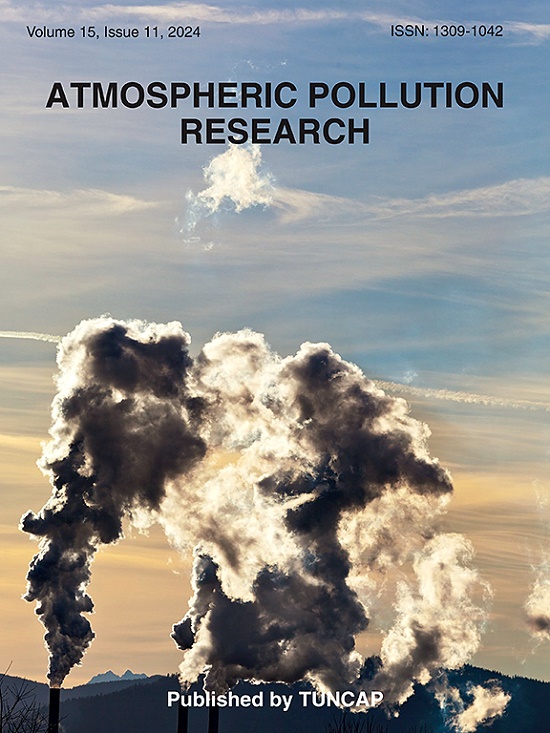Causes, emission characteristics, and health risks of persistent free radicals and reactive oxygen species in PM2.5 produced by smoldering incense
IF 3.5
3区 环境科学与生态学
Q2 ENVIRONMENTAL SCIENCES
引用次数: 0
Abstract
This study investigated persistent free radicals (PFRs) and reactive oxygen species (ROS) using electron paramagnetic resonance in PM2.5 produced by smoldering incense. The Raman spectroscopy was used to define the structure of carbon on PM2.5. The predominant type of PFRs detected was carbon-oxygen radicals, and their 1/e lifetimes range from 1,164 to 4,932 days. One identified source of PFRs was graphite structural defects, which contribute to catalytic reactivity and the subsequent production of hydroxyl radicals. Incense-generated PM2.5 produces ROS, including hydroxyl and alkyl radicals. Among the eight types of incense PM2.5 examined, PFR emission rates were found to range from 3.2E16 ± 9.0E15 to 8.8E16 ± 5.0E16 spins/g, and ROS emission rates ranged from 1.6E18 to 7.6E18 spins/g. The high chemical reactivity of both PFRs and ROS may pose significant health risks. The health risk of PFRs content in PM2.5 is often assessed using a cigarette tar-based method. It has been estimated that the amount of PM-bound PFRs generated from burning a single incense stick is approximately equivalent to that produced by the cigarette tar amount from one to two cigarettes. Non-thermal plasma intervention reduced the amount of PM2.5 but increased the concentration of PFRs and ROS. The results of real samples indicate that the concentration of PFRs in PM2.5 from indoor incense burning in suburban areas is higher than that in busy urban traffic areas. The intervention will increase the concentration of PFRs. Given the lifestyle of spending extended periods indoors, studying the incense PM2.5-bound radicals is important.
熏香产生的PM2.5中持久性自由基和活性氧的成因、排放特征及健康风险
本研究利用电子顺磁共振技术研究了熏香产生的PM2.5中持久性自由基(PFRs)和活性氧(ROS)的含量。利用拉曼光谱确定PM2.5上碳的结构。检测到的PFRs的主要类型是碳氧自由基,其1/e寿命范围为1,164至4,932天。一个确定的PFRs来源是石墨结构缺陷,这有助于催化反应活性和随后的羟基自由基的产生。烟雾产生的PM2.5会产生活性氧,包括羟基和烷基自由基。8种香PM2.5中,PFR排放速率为3.2E16±9.0E15 ~ 8.8E16±5.0E16个旋/g, ROS排放速率为1.6E18 ~ 7.6E18个旋/g。PFRs和ROS的高化学反应性可能对健康构成重大威胁。PM2.5中PFRs含量的健康风险通常采用基于香烟焦油的方法进行评估。据估计,燃烧一根香产生的pm结合PFRs的量大约相当于一到两根香烟焦油量产生的量。非热等离子体干预降低了PM2.5的量,但增加了PFRs和ROS的浓度。实测结果表明,郊区室内烧香产生的PM2.5中PFRs浓度高于城市交通繁忙区域。干预会增加PFRs的浓度。考虑到长时间呆在室内的生活方式,研究与pm2.5有关的激进分子很重要。
本文章由计算机程序翻译,如有差异,请以英文原文为准。
求助全文
约1分钟内获得全文
求助全文
来源期刊

Atmospheric Pollution Research
ENVIRONMENTAL SCIENCES-
CiteScore
8.30
自引率
6.70%
发文量
256
审稿时长
36 days
期刊介绍:
Atmospheric Pollution Research (APR) is an international journal designed for the publication of articles on air pollution. Papers should present novel experimental results, theory and modeling of air pollution on local, regional, or global scales. Areas covered are research on inorganic, organic, and persistent organic air pollutants, air quality monitoring, air quality management, atmospheric dispersion and transport, air-surface (soil, water, and vegetation) exchange of pollutants, dry and wet deposition, indoor air quality, exposure assessment, health effects, satellite measurements, natural emissions, atmospheric chemistry, greenhouse gases, and effects on climate change.
 求助内容:
求助内容: 应助结果提醒方式:
应助结果提醒方式:


